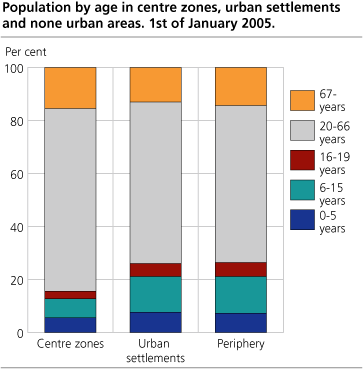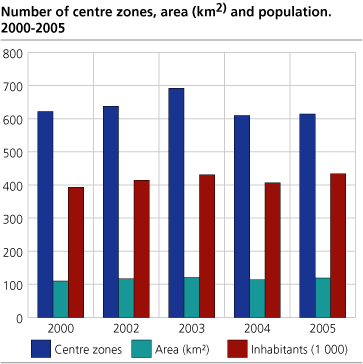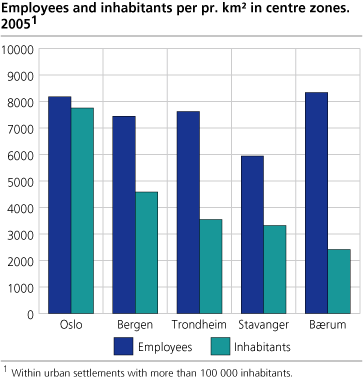Content
Published:
This is an archived release.
Few kids lives in centre zones
Few children lives in centre zones compared with other places in Norway. Nearly each third employee works in business districts, whilst only one in ten lives there. Contemporary there is a smooth increase in the centre zone population, which lives on even less land per head.
More than each fourth inhabitant in the urban settlements and in the periphery is below 20 years of age. In centre zones only 15,5 per cent are children and teenagers. (figure 1). On the other side, the share of people in age of labour force, between 20 and 66, is higher in centre zones than elsewhere. 696 275 employees works in centre zones. Almost half of them have a job in the ten largest city centres. Business districts are hence often named "the engines" in the economy. 105 centre zones have 1 000 or more employees and 563 434 employees in total.
Centre zones are more stable
After a loss of many minor centre zones in 2003, it seems like the centre zones have become more stable. Whilst it disappeared 90 centre zones in 2003, a net four new where formed in 2004. Figure 2 show that even though the number of centre zones has gone up and down, the area and population has been more or less the same. This is caused by the fluctuation of minor centre zones, which do not affect the total area or number of inhabitants. In the 338 smallest centre zones by population, there lives 200 or fewer persons.
Results from the automated mapping of centre zones and urban settlements show that only 225 out of 909 urban settlements have one or more centre zones. Total centre zone area is 118,79 km2, or one 20t h of the total area of the urban settlements. For the remaining 684 urban settlements, which all are small counted by number of inhabitants, it was not possible to localise centre zones according to criteria's that form basis for the statistics.
Lack of space
As of 1r s t of January 433 920 persons lived in the centre zones. Less than 10 per cent of the population lives in centre zones. On the other side they live twice as densely. In urban settlements there are in average 1 600 inhabitants per square kilometre, but people in the most populated municipalities lives far more densely. In Oslo municipality there are for instance close to 8 000 inhabitants per square kilometre in the centre zones. Figure 3 show that the difference between the five most populated municipality centres is large. In Oslo there are about the same number of inhabitants and employees per square kilometre in centre zones within the largest urban settlement. In the other municipalities we find that the concentration of inhabitants is far lower than in Oslo, but the concentration of employees is almost the same.
|
Important terms
Statistics Norway definition:
1. A centre zone consists of one or more centre kernels and a 100 metre zone around them. 2. A centre kernel is an area with more than 3 different main types of economic activity with centre functions. In addition to detail trade, governmental administration or health and social services or social and personal service must be present. The distance among enterprises must not be more than 50 meters. |
Digital centre zone boundaries delimited pr 1 January 2005 can be downloaded here.
Additional information
This statistics monitor the development in centre zones in relation to residents, employees and density. Based on automatic delimitation of the centre zones.
Contact
-
Erik Engelien
E-mail: erik.engelien@ssb.no
tel.: (+47) 91 12 55 45
-
Jørn Kristian Undelstvedt
E-mail: jorn.kristian.undelstvedt@ssb.no
tel.: (+47) 94 50 68 64



